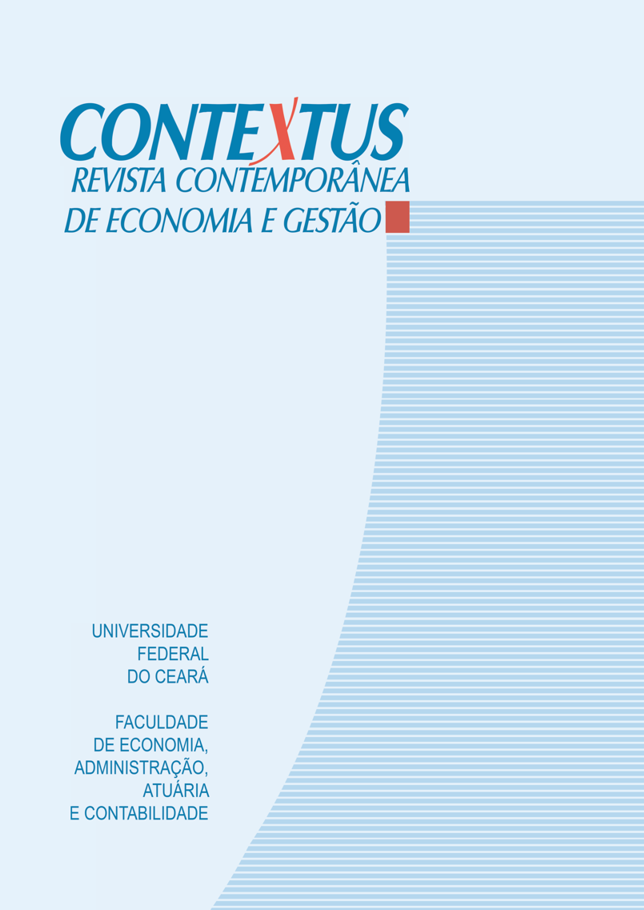Utilização da abordagem QFD-Fuzzy para apoiar decisões de investidores: Um estudo sobre negócios digitais de rápido crescimento em Londres
DOI:
https://doi.org/10.19094/contextus.2023.82986Palavras-chave:
estratégia de crescimento, negócios digitais, decisões de investimento, matriz QFD-Fuzzy, números FuzzyResumo
O trabalho analisa estratégias de expansão de negócios digitais de rápido crescimento, a fim de desenvolver uma metodologia para apoiar decisões de investidores. Foi realizada uma pesquisa qualitativa com os CEOs e fundadores de 119 startups, seguida do desenvolvimento de uma matriz QFD-Fuzzy, para avaliar o impacto das características chave das empresas nas opções estratégicas de crescimento. Constatou-se que o número de funcionários e a intenção de captar recursos no curto prazo foram os elementos menos determinantes para as estratégias de crescimento dessas empresas, enquanto a captação de recursos e as taxas de crescimento foram os aspectos mais determinantes que influenciaram as decisões dos empreendedores. Também foi demonstrado que a Matriz QFD-Fuzzy pode ser adaptada para apoiar decisões de investidores.
Referências
Akao, Y., & Mazur, G. H. (2003). The leading edge in QFD: Past, present and future. International Journal of Quality & Reliability Management, 20(1), 20-35. https://doi.org/10.1108/02656710310453791
Araújo, M. F., & Trabasso, L. G. (2013). Applying QFD to business development environment. Journal of the Brazilian Society of Mechanical Sciences and Engineering, 35, 131-142. https://doi.org/10.1007/s40430-013-0010-5
Asemokha, A., Musona, J., Torkkeli, L., & Saarenketo, S. (2019). Business model innovation and entrepreneurial orientation relationships in SMEs: Implications for international performance. Journal of International Entrepreneurship, 17(3), 425-453. https://doi.org/10.1007/s10843-019-00254-3
Assefa, D. Z., Colovic, A., & Misganaw, B. A. (2022). Firm size, firm age and business model innovation in response to a crisis: Evidence from 12 countries. International Journal of Innovation Management, 2250054. https://doi.org/10.1142/S1363919622500542
Atherton, A. (2012). Cases of start‐up financing. International Journal of Entrepreneurial Behavior & Research, 18(1), 28-47. https://doi.org/10.1108/13552551211201367
Autio, E., Nambisan, S., Thomas, L. D. W., & Wright, M. (2018). Digital affordances, spatial affordances, and the genesis of entrepreneurial ecosystems. Strategic Entrepreneurship Journal, 12(1). https://doi.org/10.1002/sej.1266
Bottani, E. (2009). A fuzzy QFD approach to achieve agility. International Journal of Production Economics, 119(2), 380-391. https://doi.org/10.1016/j.ijpe.2009.02.013
Bradshaw, M., Drake, M., Pacelli, J., & Twedt, B. (2022). Brokerage house initial public offerings and analyst forecast quality. Management Science, ahead of print. https://doi.org/10.1287/mnsc.2022.4610
Bruton, G. D., Filatotchev, I., Chahine, S., & Wright, M. (2010). Governance, ownership structure, and performance of IPO firms: The impact of different types of private equity investors and institutional environments. Strategic Management Journal, 31(5), 491-509 https://doi.org/10.1002/smj.822
Burger, A., Hogan, T., Kotnik, P., Rao, S., & Sakinç, M. E. (2023). Does acquisition lead to the growth of high-tech scale-ups? Evidence from Europe. Research in International Business and Finance, 64, 101820. https://doi.org/10.1016/j.ribaf.2022.101820
Bustamante, C. V., (2019). Strategic choices: Accelerated startups' outsourcing decisions. Journal of Business Research, 105 (C), 359-369. https://doi.org/10.1016/j.jbusres.2018.06.009
Cantamessa, M., Gatteschi, V., Perboli, G., & Rosano, M. (2018). Startups’ roads to failure. Sustainability (Switzerland), 10(7), 2346. https://doi.org/10.3390/su10072346
Cavallo, A., Ghezzi, A., Dell’Era, C., & Pellizzoni, E. (2019). Fostering digital entrepreneurship from startup to scaleup: The role of venture capital funds and angel groups. Technological Forecasting and Social Change, 145(C), 24-35. https://doi.org/10.1016/j.techfore.2019.04.022
Cheng, B. W., & Chiu, W. H. (2007). Two-dimensional quality function deployment: An application for deciding quality strategy using fuzzy logic. Total Quality Management and Business Excellence, 18(4), 451-470. https://doi.org/10.1080/14783360701231948
Chowdhury, M. M. H., Agarwal, R., & Quaddus, M. (2019). Dynamic capabilities for meeting stakeholders’ sustainability requirements in supply chain. Journal of Cleaner Production, 215, 34-45. https://doi.org/10.1016/j.jclepro.2018.12.222
Ciasullo, M.V., Montera, R., Mercuri, F., & Mugova, S. (2022). When digitalization meets omnichannel in international markets: A case study from the agri-food industry. Administrative Sciences, 12(2), 68. https://doi.org/10.3390/admsci12020068
Costa, J. F., Araújo, A. G., Cabral, E. L. S., Severo, R. A. N. F., Barreto, J., & Freitas, R. (2021). The use of a QFD approach to support investors’ decisions: A study on fast growing digital businesses in London. 45th ANPAD Annual Event, Brazil, 45.
Costa, J. F., Jr., Rezende, J. F. D., Cabral, E. L. S., Florentino, D. R. M., & Soares, A. R. (2018). The impact of big data on SME´s strategic management: A study on a small British enterprise specialized in business intelligence. Journal of Management and Strategy, 9(4), 10-21. https://doi.org/10.5430/jms.v9n4p10
Cremades, A. (2016). The Art of Startup Fundraising. New York: Wiley.
Crosier, L. P. (2004). Selling your business: The transition from entrepreneur to investor. New York: John Wiley & Sons.
Cumming, D., Kumar, S., Lim, W. M., & Pandey, N. (2022). Mapping the venture capital and private equity research: A bibliometric review and future research agenda. Small Business Economics, 1-49. https://doi.org/10.1007/s11187-022-00684-9
Dai, N., Jo, H., & Kassicieh, S. (2012). Cross-border venture capital investments in Asia: Selection and exit performance. Journal of Business Venturing, 27(6), 666-684. https://doi.org/10.1016/j.jbusvent.2011.04.004
Daunfeldt, S. O., & Halvarsson, D. (2015). Are high-growth firms one-hit wonders? Evidence from Sweden. Small Business Economics, 44, 361-383. https://doi.org/10.1007/s11187-014-9599-8
Davidsson, P., Delmar, F., & Wiklund, J. (2019). Measuring growth: Methodological considerations and empirical results. In Entrepreneurship and SME Research: On its Way to the Next Millennium (pp. 199-216). Aldershot, England: Ashgate. https://doi.org/10.4337/9781781009949.00011
Davila, A., Foster, G., & Gupta, M. (2003). Venture capital financing and the growth of startup firms. Journal of Business Venturing, 18(6), 689-708. https://doi.org/10.1016/S0883-9026(02)00127-1
Drover, W., Busenitz, L., Matusik, S., Townsend, D., Anglin, A., & Dushnitsky, G. (2017). A review and road map of entrepreneurial equity financing research: Venture capital, corporate venture capital, angel investment, crowdfunding, and accelerators. Journal of Management, 43(6), 1820-1853. https://doi.org/10.1177/0149206317690584
Dutta, S., & Folta, T. B. (2016). A comparison of the effect of angels and venture capitalists on innovation and value creation. Journal of Business Venturing, 31(1), 39-54. https://doi.org/10.1016/j.jbusvent.2015.08.003
Frank, A. G., Souza, D. V. S., Ribeiro, J. L. D., & Echeveste, M. E. (2013). A framework for decision-making in investment alternatives selection. International Journal of Production Research, 51(19), 5866-5883. https://doi.org/10.1080/00207543.2013.802393
García-García, R., García-Canal, E., Guillén, M.F. (2022). Walking on thin ice: CEOS′ internationalization decisions in underperforming firms. Long Range Planning, 55(5), 102243. https://doi.org/10.1016/j.lrp.2022.102243
Gupta, G., & Bose, I. (2019). Digital transformation in entrepreneurial firms through information exchange with operating environment. Information and Management, 59(3), 103243. https://doi.org/10.1016/j.im.2019.103243
Haiyun, C., Zhixiong, H., Yüksel, S., & Dinçer, H. (2021). Analysis of the innovation strategies for green supply chain management in the energy industry using the QFD-based hybrid interval valued intuitionistic fuzzy decision approach. Renewable and Sustainable Energy Reviews, 143, 110844. https://doi.org/10.1016/j.rser.2021.110844
Hellmann, T., & Puri, M. (2002). Venture capital and the professionalization of start‐up firms: Empirical evidence. The Journal of Finance, 57(1), 169-197. http://www.jstor.org/stable/2697837
Hellmann, T., & Thiele, V. (2015). Friends or foes? The interrelationship between angel and venture capital markets. Journal of Financial Economics, 115(3), 639-653. https://doi.org/10.1016/j.jfineco.2014.10.009
Hellmann, T., & Thiele, V. (2022). Scaling versus selling startups: The role of foreign acquirers in entrepreneurial ecosystems. SSRN. https://doi.org/10.2139/ssrn.4033748
Henn, R., Terzidis, O., Kuschel, K., Leiva, J.C., & Alsua, C. (2022). One step back, two steps forward: Internationalization strategies and the resilient growth of entrepreneurial ecosystems. Small Enterprise Research, 29(3), 273-307. https://doi.org/10.1080/13215906.2022.2134191
Huang, J., Henfridsson, O., Liu, M. J., & Newell, S. (2017). Growing on steroids: Rapidly scaling the user base of digital ventures through digital innovaton. MIS Quarterly: Management Information Systems, 41(91), 301-314. https://doi.org/10.25300/MISQ/2017/41.1.16
Jeon, E., & Maula, M. (2022). Progress toward understanding tensions in corporate venture capital: A systematic review. Journal of Business Venturing, 37(4), 106226. https://doi.org/10.1016/j.jbusvent.2022.106226
Joseph, G., Aboobaker, N., & Ka, Z. (2023). Entrepreneurial cognition and premature scaling of startups: A qualitative analysis of determinants of start-up failures. Journal of Entrepreneurship in Emerging Economies, 15(1), 96-112. https://doi.org/10.1108/JEEE-11-2020-0412
Karasan, A., Ilbahar, E., Cebi, S., & Kahraman, C. (2022). Customer-oriented product design using an integrated neutrosophic AHP & DEMATEL & QFD methodology. Applied Soft Computing, 118, 108445. https://doi.org/10.1016/j.asoc.2022.108445
Kargari, M. (2018). Ranking of performance assessment measures at Tehran Hotel by combining DEMATEL, ANP, and SERVQUAL models under fuzzy condition. Mathematical Problems in Engineering, 2018, 1-11. https://doi.org/10.1155/2018/2F5701923
Kinker, P., Swarnakar, V., Singh, A. R., & Jain, R. (2021). Prioritizing NBA quality parameters for service quality enhancement of polytechnic education institutes – A fuzzy Kano-QFD approach. Materials Today: Proceedings, 47(17), 5788-5793. https://doi.org/10.1016/j.matpr.2021.04.122
Kirwan, P., Ratinho, T., Van Der Sijde, P., & Groen, A. J. (2019). The early development of International New Ventures: a multidimensional exploration. International Journal of Entrepreneurial Behaviour and Research, 25(6), 1340-1367. https://doi.org/10.1108/IJEBR-12-2017-0508
König, M., Ungerer, C., Baltes, G., & Terzidis, O. (2019). Different patterns in the evolution of digital and non-digital ventures’ business models. Technological Forecasting and Social Change, 146(C), 844-852. https://doi.org/10.1016/j.techfore.2018.05.006
Kuschel, K., & Lepeley, M. T. (2016). Women start-ups in technology: Literature review and research agenda to improve participation. International Journal of Entrepreneurship and Small Business, 27(2-3), 333-346. https://doi.org/10.1504/IJESB.2016.073995
Lévesque, M., Joglekar, N., & Davies, J. (2012). A comparison of revenue growth at recent-IPO and established firms: The influence of SG&A, R&D and COGS. Journal of Business Venturing, 27(1), 47-61. https://doi.org/10.1016/j.jbusvent.2010.08.001
Li, L., Su, F., Zhang, W., & Mao, J. Y. (2018). Digital transformation by SME entrepreneurs: A capability perspective. Information Systems Journal, 28(6), 1129-1157. https://doi.org/10.1111/isj.12153
Lima, F. R., Jr., Osiro, L., & Carpinetti, L. C. R. (2014). A comparison between Fuzzy AHP and Fuzzy TOPSIS methods to supplier selection. Applied Soft Computing, 21, 194-209. https://doi.org/10.1016/j.asoc.2014.03.014
Ma, H., Lu, X., & Xie, X. (2014). Business exit as a deliberate strategy for incumbent firms. Organizational Dynamics, 43(4). https://doi.org/10.1016/j.orgdyn.2014.09.003
Meglio, O., Destri, A. M., & Capasso, A. (2017). Fostering dynamic growth in new ventures through venture capital: Conceptualizing venture capital capabilities. Long Range Planning, 50(4), 518-530. https://doi.org/10.1016/j.lrp.2016.09.003
Mehta, K., Sharma, R., Vyas, V., & Kuckreja, J. S. (2022). Exit strategy decision by venture capital firms in India using fuzzy AHP. Journal of Entrepreneurship in Emerging Economies, 14(4), 643-669. https://doi.org/10.1108/JEEE-05-2020-0146
Mihailova, I. (2022). Business model adaptation for realized international scaling of born-digitals. Journal of World Business, 101418. https://doi.org/10.1016/j.jwb.2022.101418
Monteiro, G. F. A. (2019). High-growth firms and scale-ups: a review and research agenda. RAUSP Management Journal, 54(1). https://doi.org/10.1108/RAUSP-03-2018-0004
Moss, D. L. (2022). Toward a coherent approach to market power in the digital sector: Complexity, growth through acquisition, and remedies. The Antitrust Bulletin, 67(4), 536-551. https://doi.org/10.1177/0003603X221126139
Nambisan, S. (2017). Digital entrepreneurship: Toward a digital technology perspective of entrepreneurship. Entrepreneurship: Theory and Practice, 41(6), 1029-1055. https://doi.org/10.1111/etap.12254
Ocampo, L. A., Aro, J. L., Evangelista, S. S., Maturan, F., Atibing, N. M., Yamagishi, K. D., & Selerio, E. F. (2022). Synthesis of strategies in post-COVID-19 public sector supply chains under an intuitionistic fuzzy environment. Socio-Economic Planning Sciences, 85, 101340. https://doi.org/10.1016/j.seps.2022.101340
Paik, Y., & Woo, H. (2017). The effects of corporate venture capital, founder incumbency, and their interaction on entrepreneurial firms’ R & D investment strategies. Organization Science, 28(4), 597-780. https://doi.org/10.1287/orsc.2017.1133
Park, S., & LiPuma, J. A. (2020). New venture internationalization: The role of venture capital types and reputation. Journal of World Business, 55(1). https://doi.org/10.1016/j.jwb.2019.101025
Pisoni, A., & Onetti, A. (2018). When startups exit: Comparing strategies in Europe and the USA. Journal of Business Strategy, 39(3), 26-33. https://doi.org/10.1108/JBS-02-2017-0022
Potočnik, K., Anderson, N. R., Born, M., Kleinmann, M., & Nikolaou, I. (2021). Paving the way for research in recruitment and selection: Recent developments, challenges and future opportunities. European Journal of Work and Organizational Psychology, 30, 159-174. https://doi.org/10.1080/1359432X.2021.1904898
Rasmussen, E., Mosey, S., & Wright, M. (2011). The evolution of entrepreneurial competencies: A longitudinal study of university spin-off venture emergence. Journal of Management Studies, 48(6), 1314-1345. https://doi.org/10.1111/j.1467-6486.2010.00995.x
Rehman, O., Ali, Y., & Sabir, M. (2022). Risk assessment and mitigation for electric power sectors: A developing country’s perspective. International Journal of Critical Infrastructure Protection, 36, 100507. https://doi.org/10.1016/j.ijcip.2021.100507
Rhodes, C., & Ward, M. (2020). UK Business statistics. House of Commons Library. Number 06152, 31st July. https://commonslibrary.parliament.uk/research-briefings/sn06152/v
Ries, E. (2011), The lean startup: How today’s entrepreneurs use continuous innovation to create radically successful businesses. New York: Crown Books.
Rigamonti, D., Cefis, E., Meoli, M., & Vismara, S. (2016). The Effects of the specialization of private equity firms on their exit strategy. Journal of Business Finance & Accounting, 43(9-10), 1420-1443. https://doi.org/10.1111/jbfa.12221
Rosenbusch, N., Brinckmann, J., & Müller, V. (2013). Does acquiring venture capital pay off for the funded firms? A meta-analysis on the relationship between venture capital investment and funded firm financial performance. Journal of Business Venturing, 28(3), 335-353. https://doi.org/10.1016/j.jbusvent.2012.04.002
Satisteban, J., & Mauricio, D. (2017). Systematic literature review of critical success factors of Information Technology startups. Academy of Entrepreneurship Journal, 23(2), 1-23.
Saunders, M., Lewis, P., & Thornhill, A. (2016). Research Methods for Business Students (7. ed.). Pearson Education Limited: Essex.
Shah, S. F. H., Nazir, T., & Zaman, K. (2013). A literature review on growth models and strategies: The missing link in entrepreneurial growth. Management Science Letters, 3, 2189-2200. https://doi.org/10.5267/j.msl.2013.08.004
Shen, Y., Zhou, J., Pantelous, A. A., Liu, Y., & Zhang, Z. (2022). A voice of the customer real-time strategy: An integrated quality function deployment approach. Computers & Industrial Engineering, 169, 108233. https://doi.org/10.1016/j.cie.2022.108233
Steininger, D. M. (2019). Linking information systems and entrepreneurship: A review and agenda for IT-associated and digital entrepreneurship research. Information Systems Journal, 29(2), 363-407. https://doi.org/10.1111/isj.12206
Tech Nation (2020). UK Tech for a Changing World. London: Tech Nation Report. https://technation.io/report2020/
Tekin, E., Ramadani, V., & Dana, L.-P. (2021). Entrepreneurship in Turkey and other Balkan countries: Are there opportunities for mutual co-operation through internationalisation? Review of International Business and Strategy, 31(2), 297-314. https://doi.org/10.1108/RIBS-10-2020-0133
Thomas, A., Passaro, R., & Quinto, I. (2020). Developing entrepreneurship in digital economy: The ecosystem strategy for startups growth. In B. Orlando (Org.). Strategy and Behaviors in the Digital Economy. https://doi.org/10.5772/intechopen.85423
Tippmann, E., Ambos, T. C., Del Giudice, M., Monaghan, S., & Ringov, D. (2023). Scale-ups and scaling in an international business context. Journal of World Business, 58(1), 101397. https://doi.org/10.1016/j.jwb.2022.101397
Torkayesh, A. E., Yazdani, M., & Ribeiro-Soriano, D. (2022). Analysis of industry 4.0 implementation in mobility sector: An integrated approach based on QFD, BWM, and stratified combined compromise solution under fuzzy environment. Journal of Industrial Information Integration, 30, 100406. https://doi.org/10.1016/j.jii.2022.100406
Venkatraman, V. (2017). The digital matrix: New rules for business transformation through technology. Vancouver, Canada: Greystone Books.
Verhoef, P. C., & Lemon, K. N. (2015). Advances in Customer Value Management. In R. M. Morgan, J. T. Parish & G. Deitz (Eds). Handbook of Research in Relationship Marketing (pp. 75-103). Northampton, UK: Edward Elgar.
Verhoef, P. C., Broekhuizen, T., Bart, Y., Bhattacharya, A., Dong, J. Q., Fabian, N., & Haenlein, M. (2021) Digital transformation: A multidisciplinary reflection and research agenda. Journal of Business Research, 122, 889-901. https://doi.org/10.1016/j.jbusres.2019.09.022
Von Briel, F., Davidsson, P., & Recker, J. (2018). Digital technologies as external enablers of new venture creation in the it hardware sector. Entrepreneurship: Theory and Practice, 42(1), 47-69. https://doi.org/10.1177/1042258717732779
Wallin, A., Still, K., & Henttonen, K. (2016). Entrepreneurial growth ambitions: The case of Finnish technology startups. Technology Innovation Management Review, 6(10), 5-16. https://doi.org/10.22215/timreview1023
Weinzimmer, L. G. (2000). A replication and extension of organizational growth determinants. Journal of Business Research, 48(1), 35-41. https://doi.org/10.1016/S0148-2963(98)00073-3
Wennberg, K., & DeTienne, D. R. (2014). What do we really mean when we talk about “exit”? A critical review of research on entrepreneurial exit. International Small Business Journal, 32(1). https://doi.org/10.1177/0266242613517126
Wisniewski, P. (2017). The management and performance of social media initial public offerings (IPOs): A case study analysis. In V. Benson, R. Tuninga & G. Saridakis (Eds.). Analyzing the strategic role of social networking in firm growth and productivity (pp. 1-21). IGI Global. https://doi.org/10.4018/978-1-5225-0559-4.ch001
Woo, H. (2020). Foreign venture capital firms and internationalization of ventures. Multinational Business Review, 28(3), 381-399. https://doi.org/10.1108/MBR-09-2019-0104
Yang, Z. (2022). The exit decision in the China venture capital market. Journal of Guizhou University of Finance and Economics, 40(06), 65-74.
Zadeh, L. A. (1965). Fuzzy sets. Information and Control, 8(3), 338-353. https://doi.org/10.1016/S0019-9958(65)90241-X
Zadeh, L. A. (1975). The concept of a linguistic variable and its application to approximate reasoning-III. Information Sciences, 9(1), 43-80. https://doi.org/10.1016/0020-0255(75)90017-1
Publicado
Como Citar
Edição
Seção
Licença
Os autores, no ato da submissão, aceitam a declaração abaixo:
Nós autores mantemos sobre nosso artigo publicado os direitos autorais e concedemos à revista Contextus o direito de primeira publicação, com uma licença Creative Commons na modalidade Atribuição – Não Comercial 4.0 Internacional, a qual permite o compartilhamento com reconhecimento da autoria e da publicação inicial nesta revista.
Temos ciência de estarmos autorizados a assumir contratos adicionais separadamente, para distribuição não exclusiva da versão do trabalho publicada nesta revista (ex.: publicar em repositório institucional ou como capítulo de livro), também com reconhecimento tanto da autoria, quanto da publicação inicial neste periódico.
Atestamos que o artigo é original ou inédito, não foi publicado, até esta data, em nenhum periódico brasileiro ou estrangeiro, quer em português, quer em versão em outra língua, nem está encaminhado para publicação simultânea em outras revistas.
Sabemos que o plágio não é tolerado pela revista Contextus e asseguramos que o artigo apresenta as fontes de trechos de obras citadas, incluindo os de qualquer trabalho prévio produzido e publicado pelos próprios autores.









3.png)


1.jpg)



1.jpg)


1.jpg)






.jpg)



1.jpg)

1.jpg)


1.jpg)

1.jpg)
1.jpg)
2.png)




1.jpg)
2.jpg)

1.jpg)





1.jpg)


1.jpg)
1.jpg)
